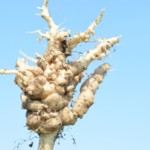
 By Anitha Chirumamilla, Ph.D., and Hans Kandel, Ph.D.
By Anitha Chirumamilla, Ph.D., and Hans Kandel, Ph.D.
Producers traditionally have swathed rather than straight-combined canola. In recent years, the availability of new pod shatter-resistant varieties has made straight cutting the new trend for canola harvesting. However, both swathing and straight combining have their places based on harvest conditions. Timely straight cutting can save time and money and result in improved canola yields and seed quality (lower harvest moisture, less green seed and higher test weight). Heavier canola stands are better suited for straight combining than thinner stands because of the decreased likelihood of shattering from wind. In the absence of pod shatter tolerance, straight combining has resulted in yield losses of 8 to 54 percent, as reported by the Canola Production Center in Canada. Read More »

 By Venkata Chapara, Ph.D.
By Venkata Chapara, Ph.D. By Anna Scharf
By Anna Scharf By Brian Caldbeck
By Brian Caldbeck By Rob Rynning
By Rob Rynning By Luis Del Rio Mendoza, Ph.D.
By Luis Del Rio Mendoza, Ph.D. By Kurtis Schroeder, Ph.D.
By Kurtis Schroeder, Ph.D. By Mike Stamm
By Mike Stamm
 By Carol J. Burns, MPH, PhD and Daland R. Juberg, PhD
By Carol J. Burns, MPH, PhD and Daland R. Juberg, PhD Ever wonder how canola oil stacks up against other edible oils? In honor of National Nutrition Month and March Madness, let’s size up the “competition,” starting with the weak challengers:
Ever wonder how canola oil stacks up against other edible oils? In honor of National Nutrition Month and March Madness, let’s size up the “competition,” starting with the weak challengers: